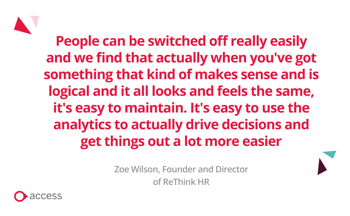
What is company culture? A working definition (for large, distributed organisations)
Company culture is the shared set of values, behaviours and practices that guide “how we do things around here,” made visible in everyday decisions and experiences. It’s everything from hiring and onboarding to recognition and performance.
CIPD evidence shows that culture is linked to outcomes leaders care about, but changing it requires deliberate, evidence‑based actions.
Why does company culture matter in distributed organisations?
In distributed organisations, where teams operate across multiple locations and time zones, company culture becomes both more challenging and more essential.
1. Alignment across distance
When teams are spread across offices and home locations, culture acts as the “operating system” that aligns decisions and behaviours without micromanagement. It helps people in different places make consistent choices rooted in shared values.
2. Engagement, productivity and retention
A strong culture correlates with consistently high engagement and productivity, the very things that support performance and lower turnover.
The CIPD’s Good Work Index (2024) highlights how job quality and design, including autonomy, meaningful work and fair treatment, impacts engagement and retention.
Consistency in these elements across locations and hybrid and remote working models is crucial for distributed organisations.
3. Risk of fractured culture in remote settings
The risk isn’t that hybrid or remote work “breaks” culture, but that unintentional culture fills the vacuum.
The challenge with remote and hybrid work isn’t that it inherently weakens company culture, but that a lack of intentional design allows disconnected or inconsistent behaviours to take root. According to Gartner, only 25% of remote or hybrid knowledge workers feel connected to their organisation’s culture, highlighting the importance of deliberate efforts to foster shared rituals and connection points. Without these, culture risks becoming fragmented, especially across distributed teams.
Common Culture Challenges in Remote Teams
- Fewer informal touchpoints: Without corridors and coffee breaks, context sharing suffers and misalignment grows unless we deliberately create new touchpoints.
- Value drift: As you scale, teams interpret values differently unless you translate them into observable behaviours and mechanisms (e.g., hiring rubrics, recognition criteria).
- Isolation and disengagement: Hybrid workers can feel disconnected; leaders need to play their part in designing a strong culture that ties the business together.
If you’re working on strengthening culture, you’ll also need to ensure you have the right people in the right roles at the right time. Read our guide on how to master workforce capacity planning in larger businesses which can help you align staffing capacity with your cultural goals and avoid resource gaps.
The foundations for building a strong culture remotely
Creating a strong company culture in a remote environment requires clarity, consistency, and deliberate action. These actions include the following steps:
1. Codify your values in behaviours and decision
Communication is key, and the key to communication is simplicity, in the context of driving a strong company culture.
Values should guide trade‑offs (“we ship quality over speed,” “we debate openly, then commit”).
Turn each value into signals (how it shows up), systems (how it’s rewarded) and stories (how you talk about it).
Evidence reviews urge leaders to focus on practical levers - policies, leadership behaviours and people systems - rather than slogans.
2. Leadership modelling and consistency
In distributed settings, the “shadow of the leader” travels through video calls, docs and chat threads.
Senior leaders must model the behaviours they expect, how they make decisions, give feedback and recognise work, because these micro‑moments are the culture.
3. Hire and promote for values alignment
Define non‑negotiable behaviours in job descriptions, interview rubrics and promotion criteria. Align leadership selection and development with the culture you want to build.
Communicating Culture Across Time Zones
- Default to asynchronous first: Use shared docs and channels (e.g., Teams, Slack, Notion) so information persists and isn’t gated behind meetings. This reduces “who you were on a call with” bias and improves inclusion across time zones.
- Regular all‑hands with context: Monthly or quarterly, led by the CEO and People leaders; use a consistent narrative arc (strategy → priorities → stories of values in action → Q&A). This creates common understanding at scale.
- Internal branding and storytelling: Spotlight teams living the values; curate a library of short videos, customer stories and “Day in the Life” features to make culture tangible.

How can you maintain a company culture remotely?
Here are some suggested practical rituals and initiatives you can implement this quarter.
- Virtual coffees & cross‑team intros: 15‑minute opt‑in pairings across departments to replace corridor collisions.
- Weekly team “shout‑outs” and wins: Close the week by recognising behaviours aligned to values; rotate the facilitator to broaden voice.
- Culture onboarding: Make your values a lived experience in the first 30–60 days. Buddy systems, “meet the culture champions,” and a founder/CEO message that explains “how we win here” are all great things to do.
- Manager “one simple thing”: Each manager logs one inclusive habit they’ll practise (e.g., round‑robin in meetings, async updates every Monday) and reviews it monthly.
Recognition programmes and feedback loops
Consistent recognition is one of the fastest ways to make values visible. Pulse surveys, peer‑to‑peer recognition and manager spot bonuses reinforce what “great” looks like in a hybrid world.
Consistent reward and recognition programmes delivered through common reward and recognition software utilised by all in the organisation are the perfect way to facilitate this for distributed workforces.
Digital‑first onboarding
Make onboarding a cultural accelerator: pre‑boarding checklists, first‑week live sessions, a 30‑60‑90 plan, and an “Ask Me Anything” with a culture champion.
This reduces time‑to‑productivity and increases belonging, both critical for remote joiners.
Tools That Support Remote Culture
- Engagement platforms: Employee engagement software utilised by all in the organisation helps promote a consistent company culture, aligning everyone behind the same communications channels and the same technology.
- Virtual team‑building: Short, purposeful formats beat long “socials.” Try 20‑minute problem‑solves, show‑and‑tell demos, or “customer story” lightning talks to build shared context.
- Culture analytics & pulse surveys: Track sentiment and belonging monthly; look for gaps by location, tenure and function to spot “cultural cold spots.”
One of the UK’s largest media groups, Reach plc employs 4,000+ people across multiple locations. By using Access’ employee benefits and engagement capabilities (including Reward & Recognition within their platform), Reach boosted platform engagement and registrations and delivered fair, personal digital rewards, supporting engagement across a distributed workforce.
Empowering Engagement Through Technology
Digital tools can replicate much of the connection and recognition people feel in physical workplaces if they’re designed around your culture and used consistently.
- Pulse surveys: Short, frequent sentiment checks that give every employee a voice and provide leaders with timely insight.
- Recognition programmes: Peer‑to‑peer and manager‑driven recognition mapped directly to your values.
- Performance & growth: Check‑ins, goals and feedback loops that prioritise coaching and clarity over annual “events.”
- Digital onboarding: Structured, role‑relevant pathways that accelerate belonging and performance.
- Employee benefits: Providing employee benefits that employees can commonly use wherever they are can also help boost company culture.
Access Employee Engagement Software brings these elements together with real‑time feedback, consistent employee communication, recognition and employee benefits so you can maintain company culture remotely and at scale, without adding admin burden to line managers.
How can you maintain company culture during growth?
- Scaling values without dilution
- Creating culture champions across departments
- Documenting and evolving cultural practices
Scaling values without dilution: Translate values into operating mechanisms, hiring scorecards, promotion criteria, decision principles and train managers to use them.
Values should be visible in how you plan, prioritise and reward. Evidence shows that focusing on climate (what people experience) is more actionable than abstract “culture” statements.
Create culture champions across departments: Trusted ICs and managers trained to model behaviours, run rituals and feed back local insights. Give them a playbook and community of practice.
Maintain a concise Culture Handbook: (values in behaviours, rituals, meeting norms), Decision Playbook (how we choose, escalate, learn), and Hybrid Working Policy. ACAS recommends clear home and hybrid working policies that set expectations and processes.
Culture during mergers or rapid hiring
Align newcomers to existing values: Build an M&A onboarding stream that links legacy practices to your current values, with clear “this stays / this changes” guidance.
Cross‑functional culture champions: Pair leaders from both sides to co‑own rituals and communications for the first 90 days.
Use tech to unify dispersed teams: Shared collaboration and engagement platforms reduce “us vs. them” dynamics by creating common spaces and norms.
As Acacium expanded, Access helped extend a bespoke, digital‑first employee benefits and engagement platform internationally (including US and Ireland), replacing paper‑based processes with greener, scalable digital alternatives such as e‑cards and digital gift card improving communications, engagement and benefits take‑up across locations.

How to measure and evolve your culture?
Choose a small set of culture KPIs, review them quarterly and publish the results to your people:
- Engagement & belonging: Pulse engagement (e.g., eNPS), psychological safety, and “I feel connected to my team/company” sentiment, cut by function, location and tenure.
- Retention & progression: Voluntary attrition, internal mobility and promotion equity are key to measure.
- Manager effectiveness: Quality of 1:1s, clarity of goals, and feedback regularity are strong measures of culture.
- Ways‑of‑working signals: Async vs. meeting ratio, response SLAs, documentation completeness.
- Conflict and wellbeing indicators: Conflict, wellbeing and job quality can all affect company culture for distributed workforces.
Run regular culture audits: Combine survey data, qualitative listening (listening groups, skip‑levels) and artefact reviews (policies, onboarding, recognition posts). Treat this like any other operating review: decide, act, communicate.
Evolve with your context: Culture is not static; it should flex with strategy, market conditions and the needs of your people. Focus on behaviours + mechanisms. These are the levers you can manage at scale.
Culture is a continuous commitment – how to make it scalable
In large, distributed organisations, culture is the sum of the everyday moments your people experience. How to build and maintain company culture comes down to a repeatable playbook: codify values into behaviours, design inclusive rituals, equip managers, measure what matters and keep evolving.
Treat culture as a strategic priority with clear owners, data and operating cadences. That’s how you maintain culture during growth, across locations and through change.
Ready to scale your culture with confidence? Book a personalised demo or explore how our all-in-one HR software solution empowers organisations to build connected, values‑driven teams no matter where they work. Utilise Access Employee Engagement Software for pulse surveys, recognition and performance insights that keep your hybrid teams connected.

 AU & NZ
AU & NZ
 SG
SG
 MY
MY
 US
US
 IE
IE
